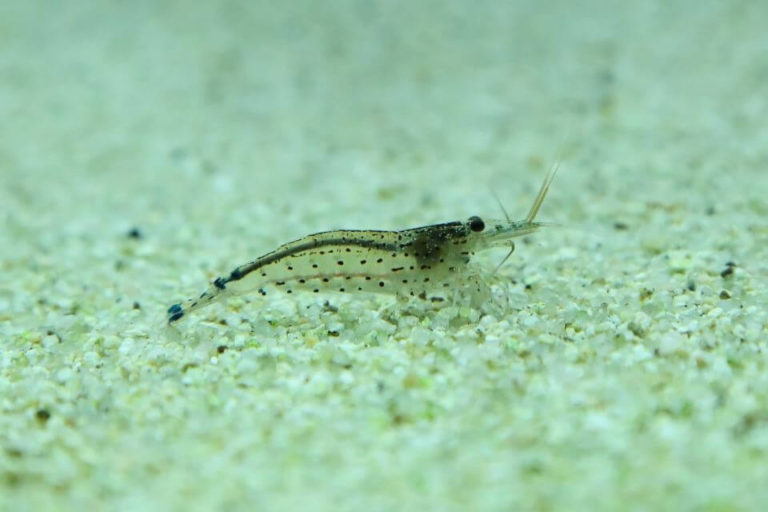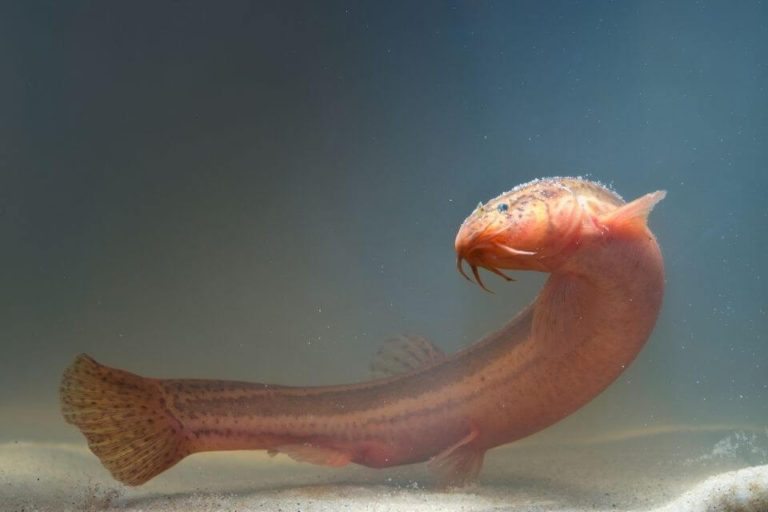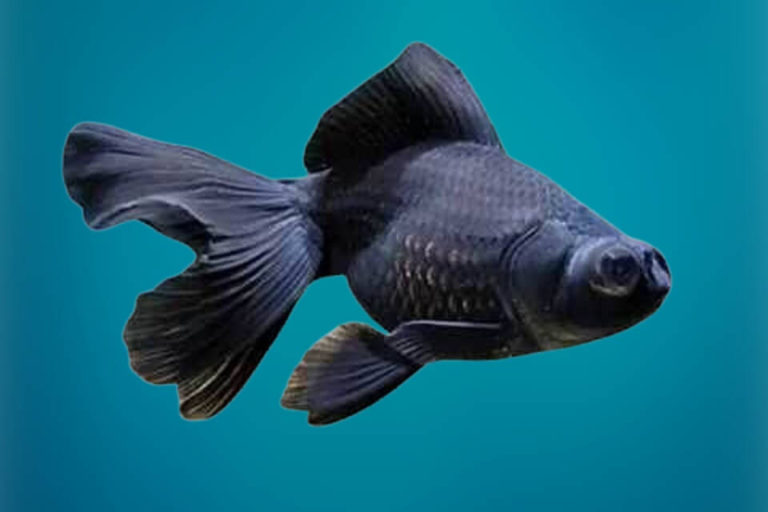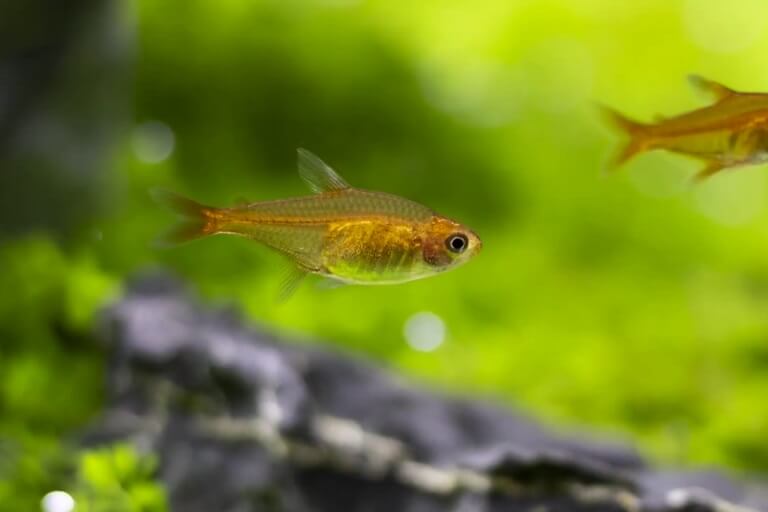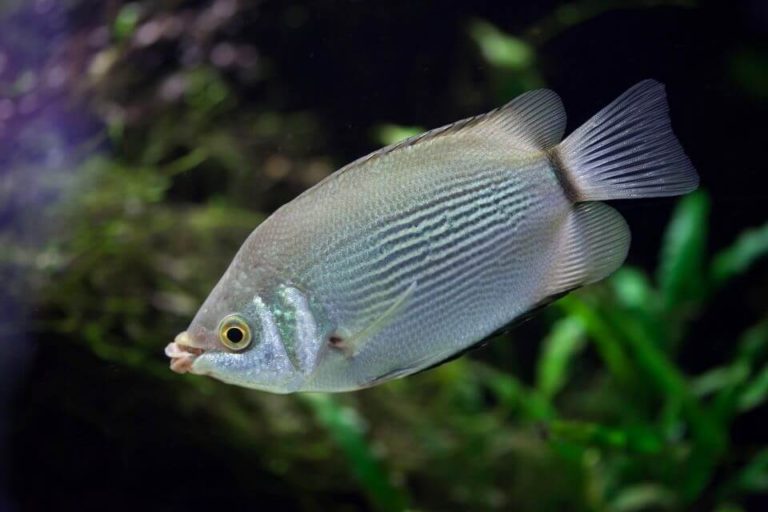Asian Arowana Species Profile and Care Guide: Keep, Diet and Breeding
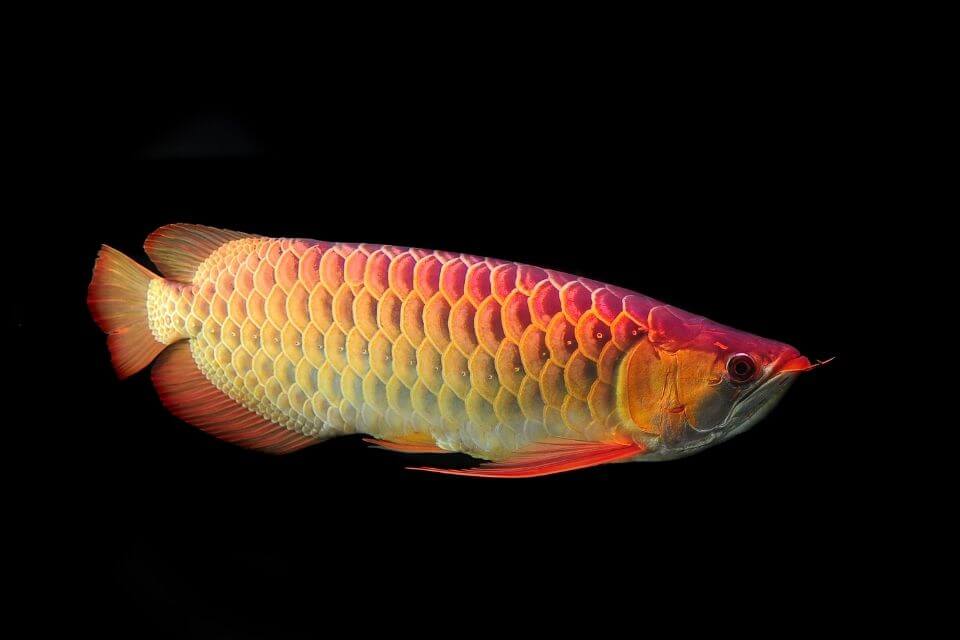
Asian Arowana fish is the most expensive freshwater fish species and one of the world’s most sought-after exotic fish. This rare gem is a true definition of what a beautiful and stunning fish is and nothing about the applause it gets is hyped.
Despite having an endangered status in the wild, captive breeding for this fish has increased to the point that there are more Asian Arowanas in aquariums than in the wild.
Currently, Asian Arowana fish is mainly found in public aquariums, especially in the USA.
However, many individuals continually realize that this is a highly valued fish that can instantly raise their aquarium value and are willing to buy this fish even at its precious price range.
If you are one of these people, this Asian Arowana care guide is for you. This guide contains all the care guidelines of this ornamental freshwater aquarium fish.
If you have any answered questions about the Asian Arowana fish or just want to know more about the hype around it, be rest assured that this guide will address all that and more.
| Quick Facts: | |
|---|---|
| Common Names : | Asian Bonytongue, Dragonfish |
| Origin : | Tropical water bodies in South East Asia |
| Family : | Osteoglossidae |
| Scientific Name : | Scleropages formosus |
| Care Level : | Medium to Hard |
| Temperament : | Semi-aggressive |
| Social : | Territorial |
| Diet : | Carnivore |
| Size (average) : | up to 36 inches long |
| Lifespan : | 10 - 15 years |
| Breeding : | Egg layer, Mouth breeder |
| Minimum Tank Size: | 250 gallons |
| Tank Environment : | Freshwater Sandy and grave mixed substrate, Rocks and Caves, Driftwood, Live aquarium plants (strong-rooted) Plastic aquarium plants |
| Temperature : | 75 – 86 °F (24 – 30 °C) |
| Water Hardness : | 2 - 8 dGH |
| Water pH Level : | 6.0 - 7.5 |
Overview of Asian Arowana Fish
Scientific name: Scleropages formosus
Other names: Asian Bonytongue, Dragonfish
The Asian Arowana fish is a long-bodied freshwater fish species that belongs to the Osteoglossidae family. The fish boasts a stunning elongated body with large coin-shaped scales.
The fish’s primary colors are red and silver and when these are combined with their relatively large size. This fish species creates an eye-catching look and a bold statement when added to a freshwater tank.
Other than its beautiful irresistible body, the Asian Arowana fish is a fish of interesting behaviors. From facultative breathing, mouth breeding to its excellent jumps, especially when feeding, this fish is truly fascinating.
Asian Arowanas are believed to bring good luck and wealth. People also believe that this fish can jump out of its tank to warn owners of bad business ventures or other coming dangers.
Whether these beliefs are true or not, the Asian Arowana fish remains one of the most exciting and attention-seeking fish you can keep in a freshwater display Aquarium.
The fish is a carnivore and will feed on absolutely any meaty food. In the wild, they jump from the water for food hanging or flying above them.
This behavior is extended to the tank creating breathtaking scenery, especially when feeding. In captivity environments, though, the fish has adapted to eat various foods, including fish pellets.
The Asian Arowana fish is a mouth breeder and the male takes charge of protecting the eggs, and then fry until they become independent young fish.
Asian Arowana Size
The maximum Asian Arowana size can grow up to is 36 inches. The direct implication of this is large tank requirements, as discussed in the tank size section later in this guide.
Note that this Asian Arowana size is the upper threshold and it can only be achieved when the fish is fed well and kept in the required water conditions.
Asian Arowana Lifespan
The Asian Arowana lifespan is long and can live for 15 years or more in captivity. This impressive Asian Arowana lifespan is another reason why this fish is worth every coin it is priced at.
Asian Arowana Typical Behavior
An Asian Arowana fish is a laid-back fish that enjoys leading a solitary life or living with its companions in small groups.
However, the males are territorial and are show highly territorial and aggressive behaviors to other male Asian Arowanas. In this regard, keeping two in one tank can be a disaster.
The Asian Arowana, especially the male fish is a mouth breeder and will protect the eggs and the young fish in their mouth until they can live independently.
Although mouth breeding is a common trait in many fish whose natural habitats in endangered, the behavior adds to this fish’s uniqueness. The other unique behavior of the Asian Arowana fish is facultative breathing.
Besides having a functional gills system, the fish can also breathe air from the water’s surface and process it with its capillaries-lined swim bladder.
Due to this trait, the Asian Arowana fish can survive in poor water conditions such as low oxygen levels, but this should be highly avoided as it brings other health risks. An Asian Arowana fish has fascinating feeding behavior.
The fish will only eat a small amount of food to remain healthy. It is even said that overfeeding can lead to loss of appetite and long-term effects of shortened lifespan and compromised breeding.
This fish can go for about three weeks without food and hence should only be fed with enough food per session. Asian Arowanas are excellent jumpers.
They take advantage of their thin and powerful bodies to jump out of the water for aerial prey. If you are feeding this fish with pellet fish food, you will enjoy it, but take precautions as some notorious Asian Arowanas are known to bite.
Origin, Distribution, and Availability
As its name suggests, this fish is endemic in South East Asia, especially Indonesia, Thailand, Malaysia, Cambodia, and Vietnam. These fish inhabit blackwater rivers and slow-moving waters that flow through wetlands and forest swamps.
This fish population has dramatically reduced in these natural habitats as a result of human activities to reclaim these areas for other farming practices.
The Asian Arowanas are mainly produced in highly guarded fish farms in Southeast Asia. Despite the fact that fish is illegal to trade in many countries, millions of these fish are moving across international markets but of course, for an atypical price.
There are over 150 farms in South Asian countries that produce Asian Arowana fish for commercial purposes. Whether this fish will recover in the natural habitats or not is a question of if human behavior of reclaiming these areas will change.
The more humans continue to interfere with this fish’s natural habitat, the harder it will become for them to recover.
Luckily and thanks to captive breeders, this fish species may not go into extinction any time soon. In fact, if proper guidelines are set on how to breed and trade the Asian Arowana internationally, its demand in the ornamental aquarium fish trade can be met.
If more and more stocks are bred, the Asian Arowana price will also go down. Because Asian Arowana fish is the most expensive freshwater fish species available. The Asian Arowana is for sale at a price between $1,500 and $300,000 whereas other Arowana species sold at $300.
Appearance, Colors, and Special Markings
The Asian Arowana is a long, narrow, and flat-bodied freshwater fish that is medium to large compared with other tank fish species. This fish species has an upturned mouth that is designed as a trapdoor to support smooth surface feeding.
An Asian Arowana fish is an Osteglossiforme, meaning that it has a bony tongue. This fish can have teeth anywhere in their mouth but have most of the teeth on the mouth’s roof and on its bony tongue.
Males have a deeper and broader mouth than females, which is better suited for mouth breeding. The bottom of their mouth has two tiny barbels that act as sensors.

The Asian Arowana fish has coin-like scales that some people (especially the Chinese) believe are a sign of good luck. Its coin-like scales and red coloration are the major reasons why it is nicknamed Dragonfish. The scales are also large enough to protect this fish from predators.
To match their long body, these fish have long pectoral, pelvic, and anal fins. The dorsal fin is short and smooth.
The scale’s color generally varies from silver to deep red but the back assumes a black color. There are variations of the Asian Arowanas in terms of color and of course, this is a result of geographical adaptations.
Aquarium Care and Conditions for Asian Arowana
– Tank Conditions and Care
Considering the value of the Asian Arowana, its tank care and conditions must be taken very seriously. Due to the Asian Arowana’s large size and proteinous diet, filtration is the number one factor you should consider when planning their tank care and conditions.
Here, you need an external filter filled with biological media. You can even install two filters on one tank, just in case one fails and it’s hard to repair it immediately.
This fish also requires a large tank with a lot of swimming space. Since the fish is not short of acrobatics, there should be a balance between the tank’s length and width. Also, this is a strong fish and a sturdy tank made of strong material is preferable.
Finally, since the Asian Arowana is an excellent jumper, you should install a tight-fitting covering to prevent their escape.
– Asian Arowana Tank Size
Asian Arowanas are large and require massive tanks. The fish can be kept with other Arowanas of a similar size provided that the tank is large enough to accommodate their tank size requirements.
The recommended minimum tank size for an adult Asian Arowana fish is 250 gallons. The tank should have a lot of swimming space, so you should be very strategic with how you add decorations to it.
Juveniles can be raised in a 60 gallons tank but should be transferred to larger tanks as they grow to prevent deformations and premature deaths.
– Tank Setup
The Asian Arowana fish can work with a bare tank or one with a sandy substrate. For the lighting, it is recommended to use LED energy-saving lights that brighten the specific color of the Arowana you are keeping.
You can also include tanning lights in the tank to improve your fish’s scales’ colorations.
You can go with driftwood, rockwork, and some sturdy plants for decorations but keep in mind that they need enough swimming space, so keep everything at the bottom or sides.
– Suitable Plants
Asian Arowanas are powerful swimmers and only sturdy plants will survive in their tank. A perfect example of such a plant is an Amazon Sword plant. Don’t include floating plants in their tanks, as they spend most of the time at the top of the tank.
– Water Conditions and Parameters
In the wild, the Asian Arowana lives in soft, warm, and acidic water. To keep the fish happy and satisfied in captivity, you should replicate these water conditions to the tank. Also, keep in mind that water conditions close to what the natural environment offers result in better coloration and more readiness to breed when the fish comes of this age.
Here are the optimum water conditions for the Asian Arowana:
Temperature: 75 – 86 °F (24 – 30°C)
Water Acidity: 6.0 – 7.5 pH
Hardness: 2 – 8 dGH
25% water changes should be done weekly to maintain its quality. Although this fish can tolerate water changes, you should avoid gradual and immediate changes.
Diet and Feeding For Asian Arowana
The Asian Arowana is a carnivore in the wild. This fish enjoys feeding on small fish, frogs, live and dead insects, and invertebrates. In a captivity environment, you should supplement with live foods.
That may include giant centipedes, mealworms, earthworms, moth larvae, and locusts. A portion of excellent food that improves the coloration of the Asian Arowana is Koi fries.
If your Asian Arowana is 12 inches and above, you should feed it on a daily basis but only with enough food.
Note that overfeeding this fish does more harm than good. Too much food can reduce the fish’s appetite and affect its breeding cycle. Instead of overloading the fish with too much food that can even compromise the tank’s integrity.
Instead, we recommend feeding the fish a small amount several times. Feeding the Asian Arowana fish with dry proprietary feeds is recommended. It ensures that the fish get all the nutrients it requires at all times.
If your Asian Arowana is not responding well to dry foods, you can get creative and insert the food in meaty snacks such as insects or shellfish. This feeding technique will benefit the fish even more.
Asian Arowana Common Diseases
Although the Asian Arowana is a hardy fish, it can be pushed by poor water conditions until it gets ill. To keep diseases at bay, you should feed your Asian Arowana with high-quality and nutritious foods and keep its tank clean at all times.
Common diseases that affect the Asian Arowana include barbels’ infection, severe fin rot, dropsy, fish lice, and fungal infections.
Isolate the Asian Arowana that shows signs of sickness if in a multi-occupied tank and reach out to your vet immediately for advice regarding the best treatment.
Remember that the Asian Arowana is a highly valued fish and losing it due to illnesses is a significant loss. Always maintain a high level of hygiene and act swiftly if your Arowana falls ill.
Asian Arowana Gender Differences
Asian Arowanas are monomorphic and are notoriously hard to sex. There are no distinguishable differences in the physical appearance of the Asian Arowanas. Lack of sexing elements makes it hard to sell and mate Asian Arowanas.
One difference that you will only notice when the fish is mature, is a broader and deeper mouth for the male compared to the female. This is the reason why the male Asian Arowana fish is excellent in mouth breeding.

Breeding the Asian Arowana
The Asian Arowanas reach sexual maturity late and are ready to breed when they are 3 to 4 years old. Breeding this fish in a home aquarium is a challenge.
This fish only breeds in natural habitats or areas such as fish farms that feel more like their natural habitats. As mentioned above, Asian Arowanas are mouth breeders.
Since the male’s mouth is better suited for this task, it handles most of the breeding work. When the female lays the eggs (10-100), the male carries them in its mouth for at least a week.
When the eggs hatch, the male continues to guard the fry for around two months or until the yolk sac is totally absorbed and young fish are in a position to live independently.
Asian Arowana Tankmates
Since this fish can sometimes be predatory, it’s relatively hard to find compatible tankmates for it. When keeping young Asian Arowanas, you should ensure that their safety is guaranteed as they are highly susceptible to bullying from other larger fish species.
The fish that will get along with the Asian Arowana fish in a community tank include:
- Angelfish
- Parrot Cichlid
- Catfish species
- Oscar Fish
- Large Plecostomus
- Knife fish
Due to the high value of the Asian Arowanas, it is risky to keep them with other fish species. It is recommended that you keep them with their own companion.
Frequently Asked Questions
Since Asian Arowana fish is an amazing fish species that you can keep in your freshwater tank. We strongly believe our guide so far did help you to get interested and know about them well.
We recommend you read the questions and answers below to make sure you do not miss anything important.
– How Many Arowanas Can Be Kept Together?
For this fish variety, it is recommended that you keep them in a group of 6 in a tank. This is even crucial if there are young ones in the tank as it reduces cases of bullying from the larger Arowanas.
The number should be reduced when keeping mature fish, depending on the size of the tank you have. Keeping two Arowanas in one tank can be a hit or a miss and it all depends on the individual personality of the fish.
If you keep one Asian Arowana fish that is full of energy with another one that is laid back, the latter may be pushed to a reduced growth rate due to factors such as lack of food. In some rare cases, you may even have to deal with cases of death.
On the other hand, you may get two fish that will cohabit excellently without any problems.
– Why is Asian Arowana Illegal?
The major reason why the Asian Arowana is illegal in many countries is that it is an endangered species. Over-fishing and destruction of its natural habitats have led to the great decline of this fish in its natural habitats.
The illegality is like a measure to protect the Asian Arowana fish from extinction. Additionally, the fish is also illegal due to the heinous acts that scrupulous people use to breed it.
Since the male Asian Arowana is a mouth breeder, people use knives and spears to kill them in order to collect the fry. Again, illegality is also a strategy to protect this gem from going through such acts.
– Why Is Arowana Banned In The USA?
Arowanas cannot be traded in the US because they are currently on the endangered species list.
The Convention on International Trade in Endangered Species of Wild Fauna and Flora, which is one of the most recognized bodies that control the trade of exotic fish, has put this fish under category 1.
Since this is the most restricted category in this fish’s classification, it is regarded as illegal in the USA. Part of the ban is also due to fear that if the fish is introduced to the USA market.
They could end up in the American freshwater bodies, where it could upset the ecosystem due to its scarcity.
– Why Are Asian Arowana So Expensive?
Due to the restrictions imposed on its trade, the Asian Arowana fish is one of the rarest fish. The implication of this is a very high retail price. The high scarcity and demand make this fish one of the most expensive aquatic pets globally.
– How Much Does An Asian Arowana Cost?
The brightly colored Asian Arowana fish for sale from $150,000 to $300,000 per fish. The high prices that this fish’s variants are sold for have made many people go to jail or pay significant fines as they try to trade the fish illegally.
– Are Asian Arowanas Aggressive?
Asian Arowanas are generally peaceful. But will get aggressive when the water conditions are poor and when the fish is not fed correctly. If you notice your fish developing some aggressive traits, it would be better if you kept it alone in its tank.
– Does Arowana Have Teeth?
Arowanas have a bony mouth with most of its mouth bones (jaw, tongue, palate, and pharynx) bearing teeth. They can develop teeth anywhere on their mouth, including on the bottom and roofs.
– Do Asian Arowana Eat Other Fish?
In the wild, an Asian Arowana is predatory and can eat fish that can fit in their mouth. In captivity conditions, they can extend this behavior. But this is rare in most cases, the food will be enough when kept in an aquarium.
Furthermore, if you keep them with fish of similar size, eating them is highly impractical.
– Will Arowanas Bite Humans?
Some Arowanas are generally notorious and there are aquarists who have reported biting incidences, especially during feeding. If this fish is kept in a community tank, the risk of getting bitten is higher as they compete for food with other fish varieties.
To prevent an Asian Arowana fish from biting anyone interacting with it, you can install divider nets on its tank.

Final Thoughts
If fish keeping is one of your major hobbies, buy the Asian Arowana fish. It definitely a sound investment and one of the gems that will raise the status of the tank you have to be lucrative.
What the fish offers in terms of appearance, behavior, and lifespan will undoubtedly match the price it comes with.
Even at its high price, this fish does not require care and maintenance. If you are a hobbyist and follow the guidelines given here, you will handle it just fine. Its price range definitely calls for some minimum level of care level, but the fish is excellent in all aspects even with this.
The Asian Arowana is not a standard fish that you will easily get in your local store. If you follow proper guidelines as set by your government, you can still acquire them without running into trouble.
While purchasing your Asian Arowana fish, make sure that you get an authentic one. You much buy from a known and reputable source. There are also fake variants that can render the huge investment you make futile.
With a good stock, you can even make your display tank a symbol of wealth. You will definitely stand out among other tank fish keepers.


